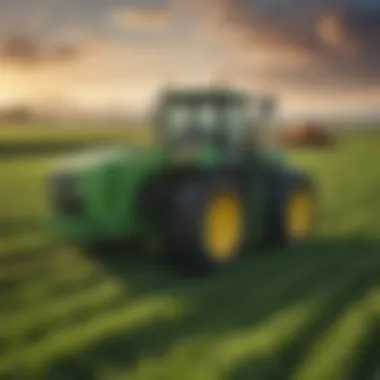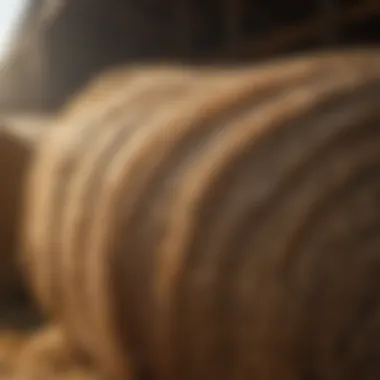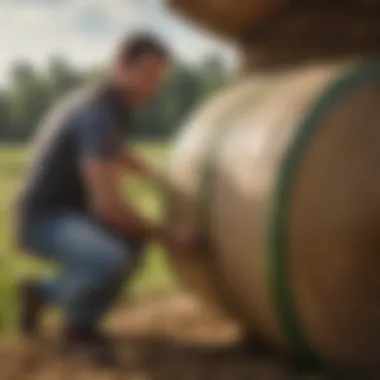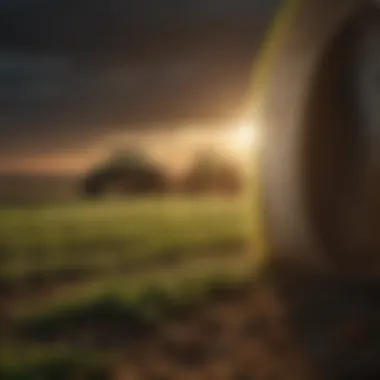Innovative Bale Tuff Silage Wrap for Enhanced Preservation


Intro
Agriculture is a domain where innovation meets tradition, especially when it comes to the preservation of feed. The preservation techniques are crucial for maintaining the quality of silage, which is essential for livestock nutrition. This article explores the functionality and benefits of bale tuff silage wrap, a modern solution aimed at enhancing agricultural preservation. It focuses on the materials, use methods, as well as future trends in this vital area of farming.
Understanding what bale tuff silage wrap entails is fundamental. By harnessing the right materials and technologies, farmers can improve silage quality and ultimately boost livestock health and productivity. This exploration aims to delineate key concepts, historical developments, recent innovations, and practical applications. The objective is to provide a comprehensive understanding of this essential agricultural tool.
Prelude to Bale Tuff Silage Wrap
Bale Tuff silage wrap stands as a pivotal element in modern agricultural practices. It offers a way to maximize the quality of silage, which plays a crucial role in livestock nutrition. Understanding this wrap’s contributions can lead to better storage solutions and improved overall farm efficiency. As farmers strive to optimize feed quality, bale tuff silage wrap emerges as an innovative technology worth exploration.
Definition and Overview
Bale Tuff silage wrap refers to a specialized plastic film designed to encapsulate silage bales. This product is integral in preventing spoilage by creating an airtight environment for fermentation. Proper wrapping techniques ensure that moisture is retained and that oxygen exposure is minimized. In essence, it is a vital tool for preserving the nutritional integrity of forage, which directly affects livestock health and productivity.
The materials used in bale tuff wrap can vary, but they are primarily composed of high-density polyethylene. This ensures durability and resilience against environmental factors such as UV rays and temperature fluctuations. The wrap's design also features characteristics that enhance its stretchability and puncture resistance, making the application process more efficient.
Historical Context
The practice of wrapping silage originated several decades ago as farmers looked for methods to improve feed storage. Early techniques involved simple plastic films that lacked the advanced properties found in today’s bale tuff wraps. These older methods often led to compromised silage quality, resulting in nutrient loss and increased feed costs.
As research evolved, the agricultural industry recognized the need for innovation in silage preservation. The introduction of high-performance plastic films revolutionized this aspect of farming. Improvements in material science have allowed for the creation of wraps that reduce the risk of spoilage while maintaining feed quality. By adopting these advancements, farmers have experienced significant benefits, including lower feed wastage and better overall livestock health.
The ongoing development in this field continues to shape how farmers approach silage management. As challenges in agriculture become more complex, innovations such as bale tuff silage wrap provide practical solutions to improve sustainability and efficiency.
Importance of Silage in Agriculture
Silage plays a crucial role in modern agricultural practices. It is a fermented feed produced from green foliage crops, which is preserved through anaerobic fermentation. There are several reasons why silage is indispensable for farmers aiming to enhance both feed quality and overall farm efficiency.
Nutritional Value for Livestock
The nutritional significance of silage cannot be overstated. Farmers depend on it to provide high-quality forage for their livestock, particularly during periods when fresh grass is not readily available.
Silage contains essential nutrients that are vital for the growth and health of animals. It is rich in carbohydrates, vitamins, and minerals, which contribute to optimal animal performance. For instance, corn silage is favored for its high energy content, supporting dairy cows during lactation. Likewise, legume silage, such as alfalfa, offers superior protein levels, which benefits meat-producing cattle. Studies show that integrating silage into livestock diets can lead to higher weight gains and improved milk yield.
Moreover, wrapping silage with materials like Bale Tuff ensures minimal oxygen exposure during storage, which preserves these nutrients effectively. This allows farmers to retrieve high-quality silage even after several months. Thus, the nutritional value of silage directly correlates with the livestock's productivity and farming profitability.
Role in Sustainable Farming
Sustainable farming practices rely heavily on effective feed management, which is where silage shines. By utilizing silage, farmers can significantly reduce waste. Leftover grains and crops can be transformed into silage rather than being discarded, promoting efficient use of resources.
Additionally, silage production helps in reducing the carbon footprint of farming operations. By maximizing the use of whole crops, farmers promote soil health and maintain biodiversity. This process supports specialized crop rotation and reduces the dependency on chemical fertilizers, which is seen as crucial for sustainable agriculture.
Furthermore, silage assists in maintaining consistent animal nutrition throughout the year. This is particularly important in adverse weather conditions, where the availability of fresh fodder may dwindle. With continuous access to high-quality silage, farmers are better equipped to adapt to climate changes and fluctuations in forage availability.
"Silage not only improves the nutritional offerings for livestock but also supports a more sustainable agricultural ethos through efficient resource use."
In summary, the importance of silage lies in its dual functionality: acting as a essential nutritional resource for livestock and serving as a pillar for sustainable agricultural practices.
Materials Used in Bale Tuff Silage Wrap
Understanding the materials used in bale tuff silage wrap is crucial for farmers aiming to optimize silage preservation. The right choice of materials contributes significantly to the effectiveness of the wrap in maintaining the quality of silage. The durability, stretchability, and resistance to environmental factors all depend on the composition of the wrap. Here, we explore the specific types of materials used and how they influence the performance of the silage wrap.


Types of Plastics
The primary component of bale tuff silage wrap is plastic, particularly polyethylene. This material offers several benefits:
- Strength: Polyethylene is known for its toughness. This durability allows it to withstand the conditions it will face in storage, including exposure to weather elements.
- UV Resistance: Some polyethylene types contain additives to increase UV resistance. This feature is essential for outdoor storage, where sunlight can degrade the wrap over time.
- Thickness Variation: Different thicknesses can be tailored to specific needs. Thicker wraps provide more protection, while thinner options might be more economical for farmers on a budget.
Another plastic that can be utilized is linear low-density polyethylene (LLDPE). It is known for its elasticity, which helps in wrapping bales tightly. An ideal wrap should minimize air pockets, which can lead to spoilage.
Additives for Enhanced Performance
While the primary material is important, additives play a vital role in enhancing the performance of the silage wrap. These additives can improve the overall effectiveness of the wrap in preserving silage quality.
- Anti-fog Agents: These additives reduce moisture buildup on the inside of the wrap. Excess moisture can encourage mold growth and spoilage of silage.
- Biocides: These substances can inhibit the growth of harmful microorganisms. Including biocides in the wrap minimizes the risk of silage deterioration, which is crucial for maintaining nutrient levels in the stored feed.
- Coloring Agents: Sometimes, coloring agents are used to enhance the visibility of the wrap. This can assist farmers in inspecting the condition of bales easily, as distinct colors can signal wear or damage.
The selection of materials and additives is not just about function; it also involves environmental considerations. Farmers are becoming more aware of how their choices affect the ecosystem. As a result, there's a growing interest in sustainable materials that do not negatively impact the environment.
"Investing in quality bale tuff silage wrap can lead to better silage outcomes, enhancing the nutrition of livestock while ensuring sustainability in agricultural practices."
In summary, the materials used in bale tuff silage wrap significantly impact the quality of stored silage. Understanding the types of plastics and the role of additives helps farmers select the best options for their specific needs, ultimately leading to improved agricultural practices.
Manufacturing Process of Bale Tuff Wrap
The manufacturing process of bale tuff wrap is crucial in ensuring that the material performs effectively in preserving silage. Understanding this process allows farmers to make informed decisions about the products they use, and it highlights the relationship between production quality and agricultural sustainability. The importance of bale tuff wrap lies not only in its physical properties but also in its production methods that enhance its functionality.
Production Techniques
The production of bale tuff wrap involves various techniques designed to create materials that offer durability and performance benefits. The starting point is the selection of appropriate plastics, which often include high-density polyethylene (HDPE) or low-density polyethylene (LDPE). These materials are favored due to their excellent moisture barrier properties and flexibility.
The process begins with the extrusion of plastic sheets. During extrusion, raw materials are heated, melted, and then forced through a die to create continuous sheets. These sheets are then stretched and oriented to improve their strength and resistance to tearing. Stretching also enhances the wrap's ability to conform to the shapes of the bales, promoting a tighter seal.
After extrusion, the sheets undergo a cooling process and are then cut into rolls. The thickness of the wrap is tailored to meet specific application needs. Typically, the thickness can vary, influencing both durability and costs. This technique ensures that the wrap can withstand outdoor conditions while preserving silage effectively.
Quality Control Measures
Quality control in the manufacturing of bale tuff wrap involves several steps that guarantee the final product meets industry standards. Regular testing of the raw materials is essential. Different tests examine aspects such as tensile strength, elongation, and puncture resistance. These parameters are critical as they determine the wrap's ability to protect silage from the elements and microbial invasion.
Once the wrap is produced, it undergoes further testing to ensure its performance under real-world conditions. This includes assessing its UV resistance and moisture retention capabilities. Any defects detected in early samples can lead to adjustments in the production process, thus preventing larger issues in bulk manufacturing.
Additionally, compliance with environmental regulations is a significant consideration during manufacturing. This means incorporating measures to minimize waste and optimize the use of resources. For instance, recycling initiatives for defective or surplus materials not only enhance sustainability but also reduce manufacturing costs.
"Maintaining high standards in the manufacturing process ensures that farmers receive a product that supports their preservation efforts effectively."
Application Techniques for Silage Wrap
The application techniques of silage wrap are crucial. They can determine the effectiveness of bale preservation. Understanding the correct methods can lead to better quality silage, which is vital for livestock nutrition. Poor wrapping can allow air and moisture to enter, resulting in spoilage. Therefore, a systematic approach to the application process is essential for effective results.
Preparing Bales for Wrapping
Before wrapping, the condition of the bales must be assessed. Density and moisture content of the forage are two fundamental factors. Ideally, the moisture content should be between 40% and 60%, as this range promotes optimal fermentation. Bales that are too wet may develop a foul smell, while dry bales can lead to poor fermentation.
Furthermore, the bales must be compact and well-shaped. This ensures that the silage wrap can cling effectively. Producers should also consider environmental elements. Avoid wrapping in wet conditions as it compromises the wrapping quality and increases spoilage risk.
Proper Wrapping Methods


Proper wrapping methods significantly enhance the preservation quality. When applying bale tuff silage wrap, it is essential to overlap the layers properly. Aim for at least 50% overlap to create a tight seal. Although manual wrapping is sometimes used, utilizing a wrapping machine is often more efficient.
When wrapping, start at the bottom and work your way up. This technique allows air to escape as the wrap is applied. Always maintain consistent tension to prevent loose sections. If the wrap is too loose, it can tear easily, which leads to air pockets. [1]
Additionally, using a stretchable silage wrap is beneficial. The stretchiness helps in conforming tightly around the bale and minimizes air exposure.
Storage Considerations
Once the bales are wrapped, their storage is pivotal. The storage site should be chosen carefully; ideally, it should be dry and away from direct sunlight. UV exposure can degrade the wrap material over time, affecting its integrity.
Consider creating a dedicated storage area to group the wrapped bales. This prevents contamination and improves accessibility. Stacking wrapped bales is an option, but it is crucial to avoid placing weight on top of them. Excess pressure can cause damage, compromising the preservation process.
In sum, the practices involved in the application techniques of silage wrap are vital for ensuring the long-term quality and nutritional value of the silage. Proper preparation, wrapping, and storage methods all play significant roles in the overall success of using bale tuff silage wrap.
By incorporating these techniques, farmers can maximize their investment in silage wrap while ensuring their livestock receive high-quality feed.
Benefits of Using Bale Tuff Silage Wrap
Bale Tuff silage wrap offers a range of benefits that significantly impact agricultural practices. The inherent properties of the material, combined with innovative manufacturing processes, enhance its appeal to farmers. Key aspects to examine include improved aerobic stability and enhanced nutrient preservation, which are essential in maintaining the quality of silage.
Improved Aerobic Stability
One of the main advantages of using Bale Tuff silage wrap is its ability to improve aerobic stability. When silage is stored, exposure to oxygen can lead to undesirable fermentation processes, resulting in spoilage and reduced feed quality. Bale Tuff wrap minimizes exposure to air, thereby limiting aerobic organisms from thriving.
It is essential to note that any gaps or imperfections in wrapping can compromise this benefit. Proper application techniques, as discussed earlier in the article, ensure a tight seal around the bales. Farmers observing improvements in aerobic stability often report better retention of silage quality over longer storage periods. This leads to more reliable feed availability during lean times for livestock.
"The investment in Bale Tuff wrap pays off through improved feed quality, ultimately impacting the farm's productivity and profitability."
Enhanced Nutrient Preservation
Another significant benefit of Bale Tuff silage wrap is enhanced nutrient preservation. Silage is valued for its high nutritional content, which is crucial for livestock health and productivity. Bale Tuff wrap effectively reduces the loss of essential vitamins and minerals during storage. This occurs due to its moisture-retaining properties, reducing the risk of leaching.
Farmers using Bale Tuff wrap frequently note that their livestock demonstrate better health and performance metrics. When nutrients are preserved effectively, animals are more likely to thrive. This results in better weight gain and higher milk production in dairy cattle.
Challenges and Limitations
The adoption of bale tuff silage wrap in agriculture, while beneficial, brings certain challenges and limitations that cannot be overlooked. Understanding these aspects is crucial for farmers and enthusiasts to make informed decisions about their use. The environmental impact of plastics and the associated costs are significant factors that can influence the overall sustainability of this technology.
Environmental Impact of Plastic
Bale tuff silage wrap typically consists of various types of plastic materials, which raise environmental concerns. The production and disposal of plastic contribute to pollution and greenhouse gas emissions. Many countries face challenges regarding plastic waste management, leading to landfills that cannot efficiently decompose these materials.
Farmers need to be aware of the negative implications of plastic use on their land and local ecosystems. Improper disposal, like leaving old, torn wraps in fields, poses risks to wildlife and can damage soil health. To mitigate these issues, some regions are exploring better recycling options for used silage wraps, but progress remains slow.
"The transition to biodegradable alternatives is critical in reducing the environmental footprint of agricultural practices."
Cost Considerations for Farmers
The financial aspect of using bale tuff silage wrap is another crucial consideration. Farmers face various costs, such as purchasing the wrap, equipment for application, and storage solutions. While bale tuff wrap can improve silage quality and ensure nutrient preservation, the initial investment may be substantial.
- Purchasing Costs: The price of quality bale tuff wraps can vary significantly, depending on the brand and specifications. Farmers must evaluate the trade-offs between cost and quality to find a suitable balance.
- Application and Labor Costs: Proper application techniques require time and labor. If farmers do not have the right equipment or skilled labor, additional costs may arise from hiring workers or renting machinery.
- Long-Term Financial Implications: While the effective preservation of silage can lead to enhanced livestock nutrition and ultimately, better profits, upfront costs can deter adoption.
The challenge for farmers is to find a way to align the costs with the benefits, ensuring a sustainable agricultural practice without compromising financial viability.


Future Trends in Silage Wrap Technology
The agricultural industry constantly evolves, and so does the technology surrounding silage preservation. Future trends in silage wrap technology are significant because they align with increasing demands for sustainability and efficiency. Farmers and researchers are seeking solutions that not only enhance the quality of silage but also minimize the environmental impact. As discussions surrounding agricultural practices shift toward more eco-friendly methods, understanding these trends will be crucial for farmers looking to stay ahead.
Biodegradable Alternatives
One notable trend in silage wrap technology is the development of biodegradable alternatives. Traditional plastic wraps pose significant environmental concerns, lingering for years in landfills. Biodegradable options present a viable solution by breaking down more quickly and reducing plastic waste in agriculture. These wraps are often made from renewable materials such as corn starch or other natural polymers. They are designed to provide adequate protection against spoilage and maintain feed quality while being less harmful to the environment. The dual benefit of effective preservation and sustainability makes these alternatives attractive in an industry increasingly aware of its ecological footprint.
Benefits of Biodegradable Silage Wraps:
- Lower environmental impact
- Reduced reliance on fossil fuels
- Potentially lower waste processing costs
- Increased consumer acceptance of sustainable practices
Smart Technology Integration
The integration of smart technology in silage wrap processes represents another compelling trend. Innovations such as sensors and IoT-enabled devices can monitor the condition of wrapped silage in real time. For instance, temperature and moisture sensors can alert farmers to changes that may compromise silage quality. By accessing this data through mobile applications, producers can optimize their storage methods and make informed decisions swiftly.
This smart technology not only enhances silage management but also aligns with precision agriculture practices. Such advances allow for a more targeted approach, enabling farmers to achieve better outcomes with fewer resources. The integration of smart technology into silage wrap is poised to transform traditional methods, leading to enhanced efficiency and productivity in agriculture.
Advantages of Smart Technology in Silage Wraps:
- Real-time monitoring of silage quality
- Improved decision-making based on data analytics
- Potential cost savings through enhanced resource management
- Greater overall productivity in silage preservation
"The future of agriculture will be defined by innovation, particularly in preservation methods like silage wrap."
Case Studies on Silage Quality and Bale Tuff Wrap
Examining case studies on silage quality and Bale Tuff Wrap is crucial for understanding its practical applications and real-world impact. These studies provide essential insights into the effectiveness of Bale Tuff in preserving silage quality, showcasing both successes and areas for improvement. By analyzing specific use cases, farmers can glean valuable knowledge about best practices and the benefits of using Bale Tuff compared to traditional methods.
Successful Applications
Several farms have adopted Bale Tuff Wrap with notable results. Here are some insights from successful applications:
- Increased Aerobic Stability: Farms utilizing Bale Tuff noticed a significant reduction in spoilage due to its superior sealing ability. This property minimizes air exposure, protecting the silage from aerobic degradation.
- Enhanced Feed Quality: Farmers reported that cattle showed improved health and production performance when fed from bales wrapped in Bale Tuff. Higher nutritional retention led to better growth rates and increased milk yields in dairy cattle.
- Cost Efficiency: Some case studies reveal that farms experienced reduced feed costs over time. The durability of Bale Tuff allowed for longer storage periods, ensuring that feed remained fresh while minimizing waste.
These outcomes underline the tangible benefits of utilizing Bale Tuff Wrap in everyday farming practices.
Lessons Learned
Through the analysis of various case studies, several key lessons have emerged regarding Bale Tuff Wrap:
- Importance of Proper Application: Successful wrapping techniques, crucial for optimal performance, require attention to detail. Poor application can negate the advantages of Bale Tuff. Properly preparing bales before wrapping can significantly influence storage outcomes.
- Environmental Considerations: Many farmers expressed growing concern over plastic waste. Moving forward, they emphasized the need for more biodegradable options or recycling systems to address the environmental impact of silage wraps.
- Adaptation to Local Conditions: Farmers learned that regional climatic variations affect silage quality. Bale Tuff's effectiveness can change based on humidity, temperature, and other local factors. Thus, tailoring practices to meet specific environmental conditions can optimize results.
Ultimately, these insights provide a foundation for both new and experienced farmers aiming to maximize the benefits of Bale Tuff Silage Wrap.
End
The conclusion of this article encapsulates the significance of bale tuff silage wrap in modern agriculture. It serves not just as a summary but as a reflection on the multifaceted benefits and considerations surrounding its use. Recognizing the importance of efficient silage preservation is crucial, particularly as farmers struggle to maximize feed quality to support livestock health and productivity.
In summary, bale tuff silage wrap enhances silage quality by providing effective moisture barrier and protection against external contaminants. This results in improved nutrient retention, which is vital for livestock. Moreover, the future of bale tuff wrap technology promises advancements toward biodegradable alternatives and the integration of smart technology for better monitoring and efficiency.
Summary of Key Points
- Nutritional preservation: Proper wrapping maintains the quality and nutritional value of silage, ensuring livestock receive optimal feed.
- Environmental considerations: While there are challenges related to plastic waste, innovations in materials could reduce environmental impact.
- Cost-effectiveness: Investing in high-quality bale tuff wrap can lead to long-term savings through reduced feed wastage.
- Future innovations: Emerging technologies may lead to more sustainable and efficient wrapping solutions, improving overall agricultural practices.
Final Thoughts on the Future of Bale Tuff Wrap
As we look ahead, the evolution of bale tuff silage wrap is likely to be influenced by both farmer demand and environmental regulations. The integration of sustainable materials into the production process presents a unique opportunity to address some of the ecological concerns associated with traditional plastic wraps.
Emerging trends indicate a strong move towards smart technology, enabling farmers to monitor silage quality in real time. This technological integration will likely enhance not only the efficiency of silage preservation but also support farmers in making data-driven decisions to optimize their practices.















